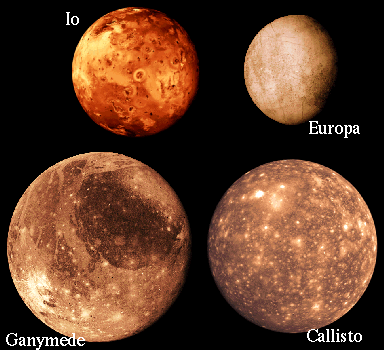The Galilean Moons of Jupiter
 Galileo's Moons
Galileo's Moons
Galileo discovered in 1610 Jupiter's four large moons
(starting from the closest in) Io,
Europa, Ganymede and Callisto, now known as the Galilean moons.
All the Galilean moons are comparable in radius to Earth's
moon, though have a varied density (indicating varying ratios
of rock and ice).
The Galilean moon system was the first discovery of a center of motion not apparently centered on the Earth. It was a major point in favor of Copernicus's heliocentric theory of the motions of the planets; Galileo's outspoken support of the Copernican theory got him in trouble with the Inquisition.
Jupiter and its Moon's have been visited by several spacecrafts, beginning in the early 1970s by Pioneer 10 and later by Pioneer 11, Voyager 1, Voyager 2 and Ulysses. The spacecraft Galileo is currently in its 8th year of a mission to study Jupiter and its moons. The spacecraft is now nearly out of the hydrazine propellant needed to keep its antenna pointed toward Earth. On Sept 21, 2003, it will die a spectacular death when it plunges into Jupiter!
A mini-solar system
The Galilean moons mimic a small solar system and we see a natural
variation of planetary conditions as one moves further from Jupiter,
like the Sun's planets. Mercury, near to the Sun, is well heated (on
the daytime side), and as you move further from the Sun, planets
get cooler. The same is true for the Galilean moons, which are
'warmer` near Jupiter. But the heat is not radiant energy, but
instead due to tidal heating.
Tidal Heating
In particular, Io and Europa are kept quite warm (heated) by
tidal interactions with Jupiter and Ganymede. The three inner
Galilean moons are in resonent lock with Jupiter, keeping the
same face towards Jupiter (just like our Moon is locked in the
direction of Earth). Io orbits twice for each orbit of Europa
which in turn orbits twice for each orbit of Ganymede. Io
should have a circular orbit, but Euorpa
and Ganymede both nudge at Io, pulling it back and forth in
its orbit. Thus Io moves closer then further from Jupiter,
the gravitational force on Io changes, causing Io to bend
back and forth (surface tide) by as much as 100 meters!